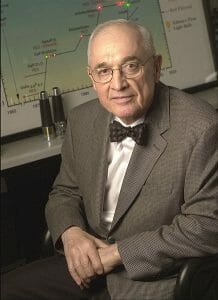Growing up in Zeigler, Ill., Holonyak’s family was poor: his parents were Rusyn immigrants (an East Slavic ethnic group from the Eastern Carpathians), and his father was a coal miner. Holonyak got a job with the Illinois Central Railroad, and after a 30-hour-straight shift decided that maybe hard labor wasn’t the kind of life he wanted. He became the first member of his family to get formal education, attending the University of Illinois at Urbana-Champaign. There he earned his bachelor’s, master’s, and PhD in electrical engineering, and was snapped up by Bell Telephone Laboratories, but only for a year: he did a two-year stint in the U.S. Army, attached to the Signal Corps. On his release in 1957, Holonyak took a position as a research scientist at the General Electric Advanced Semiconductor Laboratory in Syracuse, N.Y.

At the time, light-emitting diodes — LEDs — existed, but put out invisible infrared light. That was useful, but researchers wanted to see if they could get LEDs to glow with visible light. British scientists made some breakthroughs, but their methods were too expensive for practical use, Holonyak and his team did it, creating a red-glowing LED, which is perhaps the first kind you ever saw yourself. He then built on that to refine the technologies that led to LED-based lasers for CD and DVD players, fiber-optic communication lines, and other devices. In 1990, President George H.W. Bush awarded him the National Medal of Science, citing “his contributions as one of the Nation’s most prolific inventors in the area of semiconductor materials and devices.” In 2002, President George W. Bush awarded Holonyak and colleagues M. George Crawford and Russell Dupuis the National Medal of Technology and Innovation “For contributions to the development and commercialization of light-emitting diode (LED) technology, with applications to digital displays, consumer electronics, automotive lighting, traffic signals, and general illumination.” He also won the National Academy of Sciences’ Award for the Industrial Application of Science (1993), the IEEE Medal of Honor (2003), Russia’s Global Energy Prize (2003), the Lemelson-MIT Prize (2004), and the Draper Prize (2015), among others.
“It’s a good thing I was an engineer and not a chemist,” Holonyak said in 2012. “When I went to show them my LED, all the chemists at GE said, ‘You can’t do that. If you were a chemist, you’d know that wouldn’t work.’ I said, ‘Well, I just did it, and see, it works!’” In 1963 he returned to the University of Illinois — to teach, and to continue research. Most recently, he and Engineering professor Milton Feng developed the transistor laser, which could enable the next generation of high-speed digital communications. “We have lost a legendary member of our Illinois family,” Chancellor Robert J. Jones said, “who quite literally led everyone to see the world in a new and better way.” Dr. Holonyak died in Urbana on September 18. He was 93.
